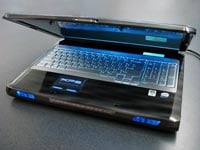Intel Core 2 Extreme Mobile X9000, Mobile Penryn Speed
Good, bad or indifferent, this is very much the tact that Intel has taken with their Santa Rosa notebook platform, utilizing the 965 Express chipset to enable 65nm Merom dual core processors over various clock speeds up to 2.8GHz, with the Core 2 Extreme X7900 currently sitting atop Intel's 65nm mobile chip offering. Also, earlier in Q1 of this year, Intel drove their new 45nm Penryn dual-core offerings down through their notebook lineup with Wolfdale-like derivatives from 2.1GHz to 2.6GHz and an 800MHz FSB with 3 - 6MB of L2 cache, depending on model number.
Today we have a look at Intel's new top-of-the-line Core 2 Mobile chip, the Core 2 Extreme Mobile X9000. At 2.8GHz with a full 6MB of L2 cache and a TDP of 44 Watts, this chip is currently Intel's fastest notebook CPU for the performance enthusiast, gaming, and multimedia markets, aka the Desktop Replacement (DTR) crowd. Our test vehicle was none other than Dell's XPS M1730 killer mobile gaming machine. A match made in heaven? Perhaps. Read on...


Dell's XPS M1730 - Now Mobile Penryn Infused
|
|
|
|
|
Model L2 Cache Frequency FSB TDP Core 2 Extreme X9000 6 MB 2.8 GHz 800 MHz 44W Core 2 Duo T9500 6 MB 2.6 GHz 800 MHz 35W Core 2 Duo T9300 6 MB 2.5 GHz 800 MHz 35W Core 2 Duo T8300 3 MB 2.4 GHz 800 MHz 35W Core 2 Duo T8100 3 MB 2.1 GHz 800 MHz 35W
Intel 45nm Core 2 Duo Mobile Products
In the specs list above you can see that this new notebook chip from Intel shares nearly an identical features list to that of the higher-end Core 2 Duo desktop chips based on Intel's Wolfdale core. However, Intel has also further enhanced this chip's power-savings capability by turning down FSB speeds to 800MHz and introducing various stages of Intel Speedstep C1 - C4 technology as well as Enhanced Deeper Sleep and Deep Power-Down states. In the processor's Deeper Sleep state, all data that resides in L2 caches is dumped to main system memory and then the cache is powered down as well to conserve power. L2 cache is high speed, low latency SRAM technology that consumers significantly more power than a standard DRAM cell. Powering down the cache also allows the Northbridge memory controller to stop making requests thus offering this "deeper" sleep state since it doesn't have to wake the processor up looking for L2 cache data that isn't there anyway.






